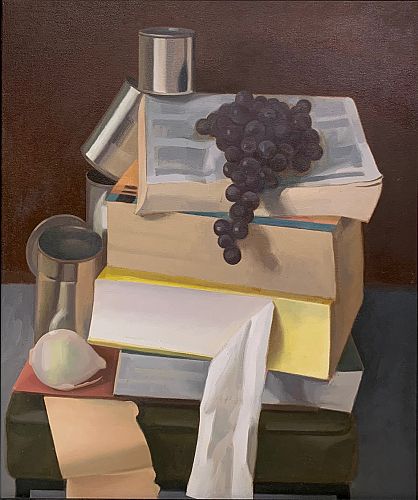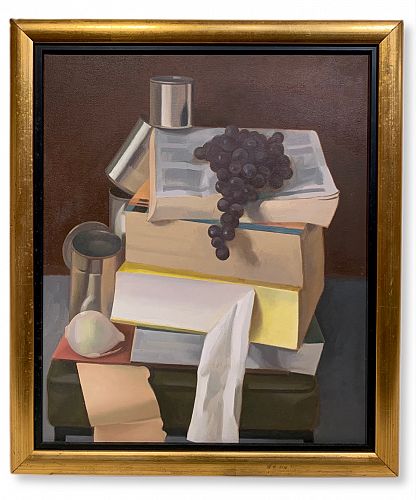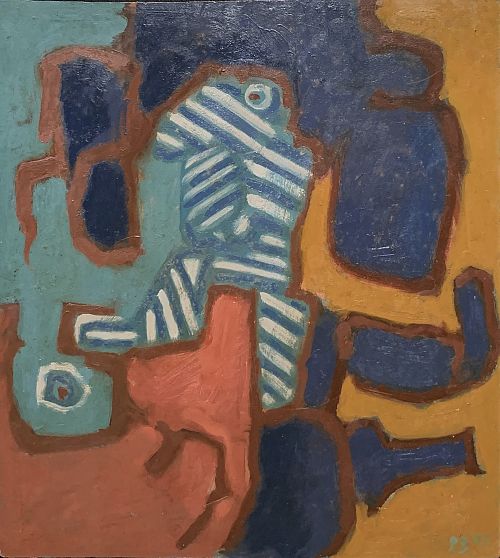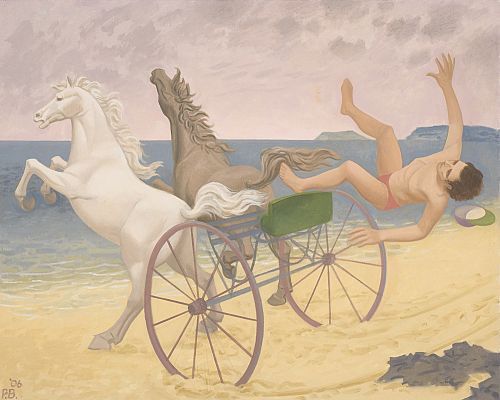Peter Blayney
Peter Michael Blayney
1920-2014
New Zealand, Australia, Europe
Statement by artist Wendy Sharpe August 2016
“Peter Blayney was one of my lecturers in Painting in the mid 1980s.
He was one of the most intelligent and articulate people I have ever met.
Always looking beyond the obvious to discuss subletities of drawing and colour that I hadn’t thought of.
He was always supportive, insightful, generous and funny.He was that rare thing, genuine artist . Not in it for money or pretence.
It was a great gift to have known him.”
•
If you require a work to be shipped contact us and we’ll recommend a suitable courier
•
click on images to zoom in
Essay by critic John McDonald 2009
Illusions: claim to have had a great many and complain that you have lost them all Flaubert’s Dictionary of Received Ideas.
“I’m laughing at myself,” Peter Blayney confesses, “but I can’t stop. There is a side to my work that is entirely ridiculous. I paint these things because I’m disillusioned with the present, but I’m an old man and I’ve a right to be disillusioned if I want to be – although I wish I wasn’t.”
There may be an overtone of humour in Blayney’s mythological paintings, but there is also a genuine fascination for the Greek and Roman legends, and a recognition of their timeless, universal relevance. Now in his eighties, Blayney made his first attempts at depicting the classical myths when he was studying ancient history at high school. In the years that followed he has painted in a naturalistic style, experimented with lyrical Abstraction, and returned to the neo-classical mode he admires in artists such as Poussin.
Elwyn Lynn once called Blayney “the overlooked artist”, and this remains true today. Having worked consistently for more than sixty years he is overdue for a survey exhibition that does justice to his long and varied career.
Although he has tried from time to time to work with greater freedom, Blayney is an intellectual painter. He has a great respect for the written word, and will think through a series before he picks up the brush. Like Poussin, and like artists such as Herbert Badham, Jean Bellette and William Dobell, who were his teachers and mentors, Blayney works hard on his compositions. His usual method is to paint a sketch in oils before moving on to a larger scale.
These mythological paintings are full of wry references to the present, and occasionally to the artist’s Australian roots. Zeus has come to Leda in the form of a black swan. Adonis, who seems rather embarrassed by the attentions of a nude Venus, is dressed casually in jeans and T-shirt. He holds a rifle – a weapon that might have saved his classical predecessor, who was killed by a wild boar.
The soldier saying farewell to his wife and child in On the Trojan Wall, could be a member of the Australian Peace Keeping Force rather than a defender of Troy. Hercules may resemble his classical self, complete with a strip of fur around his loins, and a massive club, but he has left a jeep parked in the driveway.
If Blayney’s figures are not entirely serious, neither are they merely comical. They may appear at times like characters in a soap opera, but the scenes they act out are mostly brutal and tragic. Do we see them this way? These deadpan images seem to allude to the way that movies and the media have accustomed us to violence and immunized us against tragedy. If there is one illusion that Blayney would probably wish to preserve, it is the idea that viewers may still be moved and stirred by the stories that have laid the foundations of western culture. No matter if they are depicted in T-shirts or in togas, these Greeks are our contemporaries.
John McDonald
John McDonald is art critic for the Sydney Morning Herald
Biography
1920 Born in New Zealand
1929 Moved to Australia
1939 & 1946-48 Studied at the National Art School, Sydney
1949-67 Lived in Spain, France, Italy and the United Kingdom
Solo Exhibitions
2016 Robin Gibson Gallery, Sydney
2009 Robin Gibson Gallery, Sydney
2004 Robin Gibson Gallery, Sydney
2000 Robin Gibson Gallery, Sydney
1997 Robin Gibson Gallery, Sydney
1994 Robin Gibson Gallery, Sydney
1989 Robin Gibson Gallery, Sydney
1988 Robin Gibson Gallery, Sydney
1988 Dempster’s Gallery, Melbourne
1987 Robin Gibson Gallery, Sydney
1986 Robin Gibson Gallery, Sydney
1984 Robin Gibson Gallery, Sydney
1982 Robin Gibson Gallery, Sydney
1980 Stanfield Gallery, Melbourne
1979 Town Gallery, Brisbane
1977 Town Gallery, Brisbane
1976 Waterhouse Galleries, Melbourne
1975 Town Gallery, Brisbane
1974 Macquarie Galleries, Sydney
1969 Gallery One Eleven, Brisbane
1964 Chiltern Gallery, London
Group Exhibitions
Numerous group exhibitions in France, Spain, and London & Australia
Teaching
London College of Furniture
Geffrye Museum, London
Arts Council of NSW
National Art School, Sydney
School of Art and Design, St George TAFE
City Art Institute, Sydney
Collections
University of Queensland, Brisbane
Macquarie University, Sydney
Queensland Art Gallery, Brisbane
National Gallery of Australia, Canberra
Artbank, Sydney
Bloomingdales, New York
Allen Allen & Hemsley, Sydney (Allens)
Phillips Fox, Sydney
University of NSW
Commonwealth Bank Collection
Private collections in Australia, USA and Europe
University of Technology, Sydney
Gosford Regional Gallery, Gosford NSW
Ipswich Art Gallery, Queensland
Sydney University Art Collection
Manly Art Gallery & Museum, Manly, NSW







